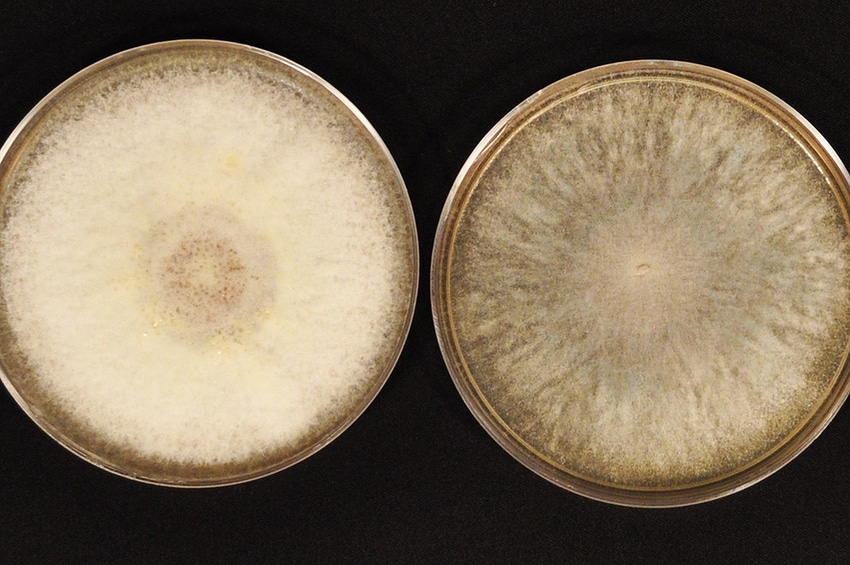Genus represents several hundred species, some of which produce harmful mycotoxins while others are used as biological controls.
August 7, 2017

David Geiser and Seogchan Kang, professors of plant pathology and environmental biology in The Pennsylvania State University's College of Agricultural Sciences, received a grant for $1.2 million from the National Science Foundation to perform the first new synthesis of taxonomy for species of the genus Fusarium in the past 30 years.
Fusarium species have broad relevance in medical and scientific research, agriculture, safety and quality of foods and urban and rural development. Some can cause disease in plants, animals and humans and produce toxins that can contaminate food.
The genus represents several hundred species, each of which can affect plants and animals in different ways, or not at all. One species may cause blight on wheat and barley, a potentially billion-dollar problem for the industry, while another species may be used as a biological control to inhibit the growth of pathogenic microbes safely and affordably.
Due to their vast diversity, varied characteristics and difficulties in differentiating them, providing effective means for accurate identification of fusarium species is beneficial for public health, business and industry.
“Despite their importance and ubiquity, the genus is in need of a complete taxonomic revision, in which only about half of the approximately 300 species we know about even have names,” Geiser said. “Currently, researchers, disease diagnosticians and citizens who have important questions about fusarium are not able to get satisfying taxonomic answers.”
Geiser and Kang’s project will produce a new monograph — a detailed and comprehensive work of writing on a single topic — of the fusarium genus. The monograph will provide a complete description of all currently known species and utilize new and existing gene sequence data as molecular fingerprints, Penn State said. It also will include introductory chapters that summarize the biological and ecological diversity of the genus.
A key feature of the monograph will be digital connectivity. It will contain hyperlinks to two key fusarium-specific resources — Fusarium isolates in major culture, and databases of DNA sequence data with a FUSARIUM-ID sequence-based classification tool. Isolates are living specimens and can be obtained by scientists for study in laboratories, greenhouses and other environments. Connecting the monograph to DNA sequence data will allow for more accurate and widely available genetic identification for researchers, agricultural and medical professionals, or anyone working with fusarium, the announcement said.
“Because plant diseases have worldwide impact, the importance of pooling such resources in a globally accessible format is essential in plant pathology,” Kang explained. “This is why we invested in building this and other online platforms.”
In addition to these two resources, the monograph will enable connections with other digital resources that can be used to catalog and research biological diversity, such as Encyclopedia of Life and Wikipedia. The goal of the project is to facilitate the discovery and recognition of new species of fusarium, even in well-studied environments such as soils and plants.
The project is international in scope, with participants at the U.S. Department of Agriculture’s Agricultural Research Service, the National Agriculture & Food Research Organization in Japan, Agriculture & Agri-Food Canada and the Westerdijk Fungal Biodiversity Institute in the Netherlands, along with other international participants anticipated to join in the future.
The project will train two doctoral students and a postdoctoral scholar, broaden the training of the primary investigators and facilitate global collaborations between diverse scientists.
In parallel with the monograph, Geiser and Kang’s team will develop a guide, "Fusarium Basics," for the many individuals who use morphology for identification. Individual species descriptions will be arranged based on evolutionary relationships and will include morphological, ecological and other information. It also will include links to lists of isolates that are available and associated data.
Geiser and Kang maintain the Fusarium database, an online collection of data, materials and knowledge from diverse areas of fusarium research, including genomics, phylogenetics, population genetics and epidemiology in a format that can be easily accessed and updated. The pair created the database in 2004.
Geiser is director of the Fusarium Research Center at Penn State. His research focuses on evolutionary genetics of pathogenic and toxic fungi, in particular Fusarium and Aspergillus; fungal genetics, systematics and evolution; and plant and animal pathogens.
Kang has expertise in fungal biology and bioinformatics. His work explores fungal genetics and genomics, microbial chemical ecology and molecular diagnosis of plant pathogens. He also maintains an online database for the plant pathogen Phytophthora, as well as one for the plant pathogen Verticillium.
You May Also Like
.png?width=300&auto=webp&quality=80&disable=upscale)


